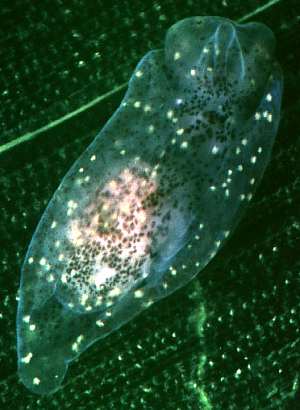
Siphopteron pohnpei
(Hoff & Carlson, 1983)
Order: CEPHALASPIDEA
Superfamily: PHILINOIDEA
Family: Gastropteridae
DISTRIBUTION
Micronesia [Pohnpei, Palau], sthn Japan [Kerama Is], Hawaii.
PHOTO
Pohnpei, Nan U (reef flat behind The Village); 6 January 2000. 4.0mm long; on the sea grass, Enhalus acoroides [C087_2]. Photo: C. Carlson & P.J. Hoff
Body translucent clear or transparent with scattered brown diffuse spots all over. The light tan to almost white viscera is visible in the dorsal hump. Larger round cream to milky yellow spots are also scattered over the dorsal surface, but most are concentrated on the parapodia and posterior end of the dorsal hump.
References:
• Gosliner,T.M. (1989): Revision of the Gastropteridae (Opisthobranchia: Cephalaspidea) with descriptions of a new genus and six new species. The Veliger, 32(4): 333-381.
• Hoff, P.J. & Carlson,C.H. (1983) Gastropteron pohnpei, a new Gastropteridae from Micronesia (Opisthobranchia: Cephalaspidea). Publications of the Seto Marine Biological Laboratory, 27(4/6): 261-264.
Rudman, W.B., 2003 (November 23) Siphopteron pohnpei (Hoff & Carlson, 1983). [In] Sea Slug Forum. Australian Museum, Sydney. Available from http://www.seaslugforum.net/find/siphpohn
Related messages
Siphopteron pohnpei from Japan.
January 20, 2004
From: Jun Imamoto

Dear Bill,
Here is a report of the distribution of a Siphopteron from Japan. It was discovered under a stone in shallow water in a sheltered bay. 2 individuals were found quite close to each other. The seaweed Ulva is very abundant in this place at this time of the year.
I think that this sea slug is Siphopteron pohnpei. A gill can be confirmed in the lower left photo.
Amami-Ooshima Islands, Kagoshima, Japan.
Size: approx 4mm, Depth: 1 m. Temperature: 21 C. 15 Jan 2004
Best Regards,
Jun Imamoto
http://www.umiushi.info/
imamoto@umiushi.info



Thanks Jun,
Yes this does seem to be S. pohnpei. As you will be aware I am very interested in finding out just what gastropterids feed on. As we don't seem to have found any identifiable stomach contents in preserved animals I have wondered whether they feed on small flatworms. I am not sure whether it is significant or not, but in your photo alongside, the animal seems to be interested in the polychaete tube worm just in front of it [see close-up inset]. I guess its possible that gastropterids eat small polychaete worms. It's certainly a possibility worth looking out for.
Best wishes
Bill Rudman
Siphopteron sp. 5 = S. pohnpei?
January 20, 2004
From: Bill Rudman
The prominent yellow spots on Jun Imamoto's photos of Siphopteron pohnpei reminded me of the yellow spots on some examples of Siphopteron sp. 5 in Nils Anthes' message from Lizard Island. Although we know nothing of the internal anatomy of Siphopteron sp. 5, it, like S. pohnpei, lacks a flagellum on the visceral hump. Interestingly, Terry Gosliner (1989) reports on a population of animals from Kaneohe Bay, Oahu, Hawaii which he identified as Siphopteron pohnpei, which showed the same colour variation from red to brown with white and yellow spots, as reported by Nils Anthes from Siphopteron sp. 5. Gosliner also reports that the different colour forms in Hawaii mate with each other.
I will wait for comments from others familiar with living Siphopteron pohnpei, but it would seem to me that Siphopteron sp. 5 is most probably S. pohnpei, which would mean its distribution extends far into the southern Pacific.
• Gosliner,T.M. (1989): Revision of the Gastropteridae (Opisthobranchia: Cephalaspidea) with descriptions of a new genus and six new species. The Veliger, 32(4): 333-381.
Best wishes
Bill Rudman
Siphopteron pohnpei from Pohnpei
November 25, 2003
From: Clay Carlson

Bill,
Here is an example of Siphopteron pohnpei (Hoff & Carlson, 1983).
• C087_2 4.0mm; Pohnpei, Nan U (reef flat behind The Village); 6 January
2000. on the sea grass, Enhalus acoroides.
In Pohnpei and Palau we find it on Enhalus. Terry Gosliner reports it from the sand in Hawaii as does Atsushi Ono from Kerama. If someone has an idea what lives on Enhalus in warm water and on the sand in cooler water, it might give us an idea what the host may be.
Clay & Patty Jo
clay.carlson@kuentos.guam.net
Carlson, C., 2003 (Nov 25) Siphopteron pohnpei from Pohnpei. [Message in] Sea Slug Forum. Australian Museum, Sydney. Available from http://www.seaslugforum.net/find/11493Dear Clay & Patty Jo,
Thanks for this addition to the Forum. Sadly we seem to be no closer to discovering just what gastropterids eat
Best wishes
Bill Rudman
